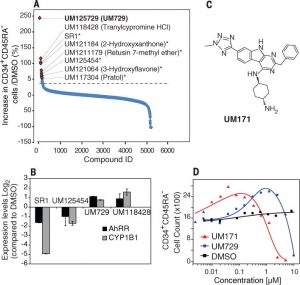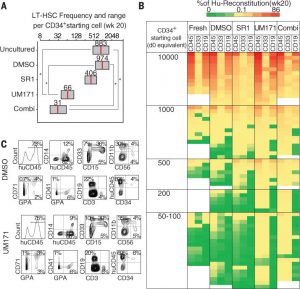This product is for research use only, not for human use. We do not sell to patients.

| Size | Price |
|---|---|
| 250mg | Get quote |
| 500mg | Get quote |
| 1g | Get quote |
Cat #: V1894 CAS #: 1448724-09-1 Purity ≥ 98%
Description: This product has been discontinued. UM171 (UM-171) is a potent agonist of human hematopoietic stem cell renewal, independently of AhR suppression. UM171 is a synthesized analog of UM729, which is screened out for its ability to expand human CD34+ CD45RA– mobilized peripheral blood cells. UM171 was 10- to 20- fold more potent than UM729 with efficacious concentrations of 17 to 19 nM. UM171 treatment enhanced the engraftment potential of CD34+ macaque cells by threefold. It was also found that UM171 had no direct effect on mitosis and no effect on the division rate of phenotypically primitive populations.
Publications Citing InvivoChem Products
Product Promise

- Physicochemical and Storage Information
- Protocol
- Related Biological Data
- Stock Solution Preparation
- Quality Control Documentation
| Molecular Weight (MW) | 453.54 |
|---|---|
| Molecular Formula | C25H27N9 |
| CAS No. | 1448724-09-1 |
| Storage | -20℃ for 3 years in powder form |
| -80℃ for 2 years in solvent | |
| Solubility In Vitro | DMSO: 45 mg/mL (99.2 mM) |
| Water: <1 mg/mL | |
| Ethanol: <1 mg/mL | |
| Synonyms | UM-171; UM 171; UM171 |
| Protocol | In Vitro | In vitro activity: UM171 is a synthesized analog of UM729, which is screened out for its ability to expand human CD34+ CD45RA– mobilized peripheral blood cells. UM171 was 10- to 20- fold more potent than UM729 with efficacious concentrations of 17 to 19 nM. UM171 treatment enhanced the engraftment potential of CD34+ macaque cells by threefold. It was also found that UM171 had no direct effect on mitosis and no effect on the division rate of phenotypically primitive populations. In addition, UM171 showed cooperation with StemRegenin (SR1) to enhance expansion of short-lived progenitors while UM171 itself selectively enhanced the long-term-HSCs. Moreover, in NSG mice, UM171 exerted effects on lymphoid-deficient differentiation in human hematopoietic reconstitution obtained by transplanting fresh or expanded cells. Cell Assay: Cells (CD34+ CB cells) were treated with 35 nM UM171 for 3, 12, 24, 48 and 72 hours. At each time point, cells were lysed, RNA was extracted and sequenced. UM171 treatment was accompanied by a marked suppression of transcripts associated with erythroid and megakaryocytic differentiation. Only six to seven genes were commonly up- or down- regulated in cells exposed to UM171. The most highly up-regulated genes in UM171-treated cells encode for surface molecules. These genes include PROCR (also called EPCR or CD201), which represents a known marker of mouse LT-HSCs. |
|---|---|---|
| In Vivo | NSG mice were injected with CD34+ CB cells that had been originally cultured in DMSO or UM171. Levels of human cell engraftment were determined for ~300 mice and represented in the form of a heat map. Analysis of this dataset indicates two emerging patterns of human reconstitution, one from predominantly lymphomyeloid LT-HSCs, observed at high cell doses with most conditions, and the other from LT-HSCs that display a lymphoid-deficient differentiation phenotype mostly observed with UM171 treatment. Neither B lymphopoiesis nor the frequency or number of lymphomyeloid LT-HSCs is negatively affected by UM171. The impact of UM171 on LT-HSC was preserved at 30 weeks posttransplantation, at which time multilineage contribution remained obvious at the high cell dose. | |
| Animal model | Mice |
| Solvent volume to be added | Mass (the weight of a compound) | |||
|---|---|---|---|---|
| Mother liquor concentration | 1mg | 5mg | 10mg | 20mg |
| 1mM | 2.2049 mL | 11.0244 mL | 22.0488 mL | 44.0975 mL |
| 5mM | 0.4410 mL | 2.2049 mL | 4.4098 mL | 8.8195 mL |
| 10mM | 0.2205 mL | 1.1024 mL | 2.2049 mL | 4.4098 mL |
| 20mM | 0.1102 mL | 0.5512 mL | 1.1024 mL | 2.2049 mL |
This equation is commonly abbreviated as: C1 V1 = C2 V2
- (1) Please be sure that the solution is clear before the addition of next solvent. Dissolution methods like vortex, ultrasound or warming and heat may be used to aid dissolving.
- (2) Be sure to add the solvent(s) in order.







































